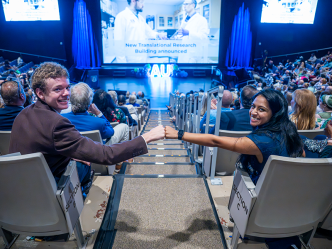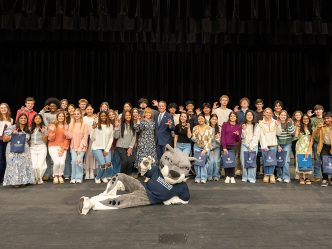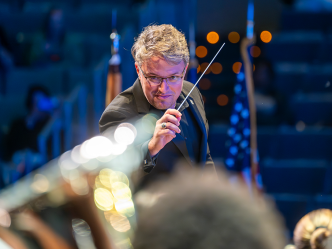All Andy Nguyen, Tyler Beauchamp and Rushay Amarath-Madav wanted to do once the pandemic started was help.
“Near the start of quarantine, we were feeling pretty disheartened about not only the state of the world, but also being in medicine during a pandemic and not being able to contribute,” said Beauchamp, who is part of the Medical College of Georgia’s Class of 2023. “We felt pretty helpless.”
Beauchamp added that it was frustrating to hear and see people around the country not adhering to social distancing guidelines while millions of frontline workers were doing everything they could to help flatten the curve and keep people safe.
So along with Nguyen (Class of 2024) and Amarath-Madav (Class of 2023), the trio began writing a song that all three say was heavily influenced by Kanye West’s “Runaway” from his 2010 “My Beautiful Dark Twisted Fantasy” album.
Amarath-Madav and Beauchamp started tinkering with lyrics about nine months ago, texting back and forth lines, but both said everything was inspired by the West’s original work.
“There are similarities in cadence and word usage throughout the song,” Amarath-Madav said. “We agreed on final lyrics after about three months of tossing ideas around and sending each other practice recordings. Some parts were ad lib and we liked it, so we kept it in the song.”
Producing the video
Beauchamp said the real heart and soul of the production is all thanks to Amarath-Madav.
“He is simply a producer, plain and simple. I mean we were just talking about lyric ideas … and then he comes in with an extracted production of the original song like it was nothing,” Beauchamp said. “And at one point we realized I couldn’t hit the high notes from the original, and on the spot, he just changed the entire production to fit my range. We wouldn’t even have had a song to work with if it wasn’t for Rushay’s talent.”
Beauchamp said it wasn’t until they met Nguyen that the full vision of the project came into view. In the beginning, Amarath-Madav and Beauchamp were filming from separate apartments on laptops on Photobooth and “it looked as bad as you can imagine … then Andy happened.”
“Not only did he completely understand our crazy brains in terms of what we were looking for visually, but he just elevated every step of the process and pushed the project beyond what we ever thought was possible,” Beauchamp said. “Every time we thought he couldn’t come up with another great idea, he came up with a better one and blew our minds.”
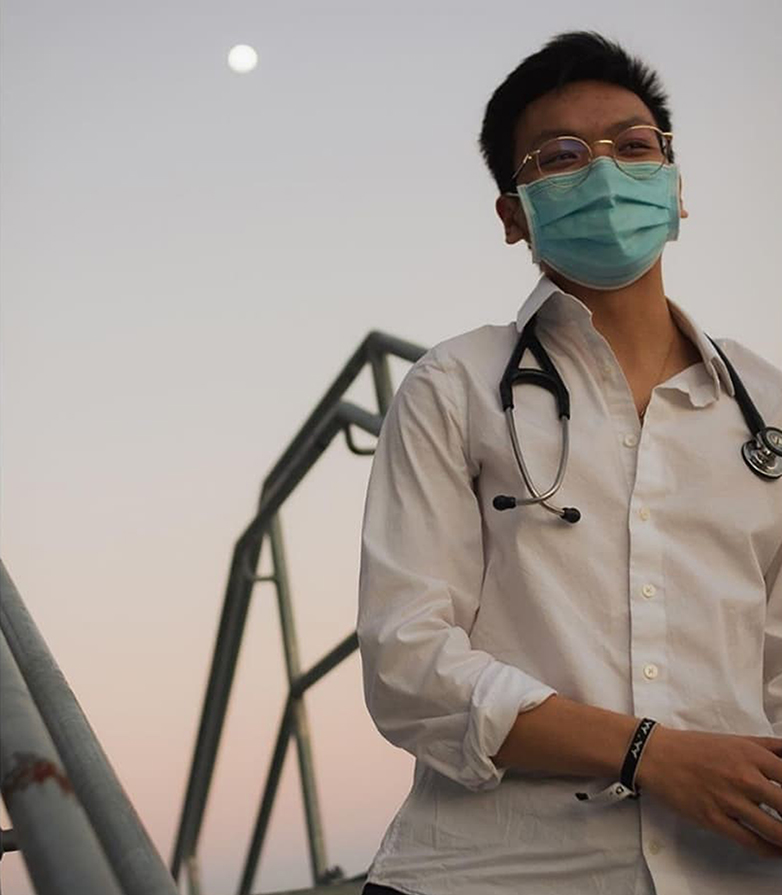
Nguyen said “My Beautiful Dark Twisted Fantasy” was an ode to West’s resurgence into his role as a hip-hop giant. He said many of the themes embodied from tracks on the album were messages of revival, resurgence and perseverance.
“When we sat down during the editing process, Rushay said ‘Runaway’ was written as a power ballad and such intention is also embodied in our work,” he said. “Those were the emotions that drove the edit of this project. This song and the visuals to go along with it was, in all definitions, a power ballad. From beginning to end, it felt like a resurgence of hope and appreciation contrasted to the images of fatigue and defeat at the beginning. That is how we want to portray the brilliant members of our community during the pandemic: as powerful heroes who rose to the challenge amidst the darkest of circumstances.”
Honoring frontline workers
In all, it took six months to plan, film, produce and edit. When they first started, there were only a handful of photos set to be displayed in the video. Amarath-Madav and Beauchamp then started reaching out to as many people as they could, asking for submissions.
“We originally had maybe six or seven photos in our rough edit of the video six months ago, and they were all from AU Health, which we were more than fine with,” Beauchamp said. “We thought it would be great to represent not only more professions but more locations and stories to illustrate just how expansive this pandemic has been for frontline workers.”
It wasn’t until a few months ago, when word got out about what they were doing, that they started receiving photos from all over.
“It amazed me every time he sent a picture in our chat and was like, ‘We have pictures from emergency responders in Alaska’ or ‘Looks like U Miami is on board now,’ until literally we had contributors from all four corners of the USA,” Nguyen said. “Then I remember us saying, ‘It would be awesome to get the CDC involved,’ then miraculously Tyler just casually tells us the CDC sent us pictures.”
The video features photos and videos from health care systems, first responders, universities and nonprofits from Georgia, Arkansas, Wisconsin, Montana, New York, Minnesota and Wyoming, to name a few.
The three would watch the video over and over, writing down notes on how to make it better. Nguyen said some of the best fun he had was going out and filming the scenes.
“I’ve had a good amount of experience directing other people from photography and past video projects, but the communication between us was so impressively unspoken that we were able to execute our shots perfectly within a couple takes, which is unheard of usually,” he said. “The editing was probably the hardest I’ve worked on … all three of us are perfectionists and with such attention to detail in our respective fields of expertise, it made the editing process incredibly fun.
“I’m truly proud of the end product and I hope anyone who watches it feels every little detail we put in.”
A toast to Ammy
There is a toast at the end of the video for Ammy, who is Beauchamp’s grandmother. He said she’s been battling cancer for the greater portion of two years, went into remission before problems resurfaced just as COVID began. He said for the entirety of quarantine, it was difficult for his family to manage work and potential COVID exposure while also taking care of her.
“But in the face of everything, she has been brave and loving … as she always is,” Beauchamp said. “Not a day went by throughout the project where I wasn’t thinking about her and the struggles my family was facing to keep her safe, which gave even more reason to thank everyone doing their part to make the world safer. But there are a lot of ‘Ammys’ out there.
“My family’s struggles were unfortunately shared by many in the past year. So while Ammy herself continually inspired us throughout the project, she represents the countless families who have struggled through the pandemic, and we hope they hear that they are not alone.”
Nguyen said before this project, he was at a crossroads as to whether he wanted to keep making videos on his YouTube channel. He said in a time of what should have been a celebration, he was met with negative feedback regarding the “traditional medical student lifestyle.”
“I am not the perfect picture of the socially accepted movie-style medical student, and that scared me,” he said. “For the first time in my life, I felt like a completely inadequate student. Don’t get me wrong, I’ve put countless hours studying and an indescribable amount of passionate work into my studies to become the best physician I can … but social media hasn’t been kind to me when it comes to self-comparison.”
Nguyen said it wasn’t until Beauchamp submitted a video of him singing that his grandmother eventually saw, did he realize the full scope of his reach.
“About halfway through this project, he told me that his grandma was in a rough spot health-wise, and the hospital that he became so familiar with as a medical student turned into a personal hell,” Nguyen said. “In the patient room, he showed her that video of him singing. Barely remembering what city she was in yet immediately recognizing her grandson, she beamed with pride.
“She quickly pushed off the initial excitement and assumed the video only got 20-30 views. He told her that it had 300 and it blew her away that her grandson could reach such an audience. … I thought that 300 views meant a plateau, she thought that 300 views was the universe.
“At a time when I thought my videos were useless, I was unknowingly giving a ray of joy in a torrential thunderstorm for a single family. This gave me the proof I needed to continue and the confirmation that these videos I make are not solely entertainment, nor are they noise. They are meant to put emotions you can’t describe into something tangible, to let you know that you are not alone.
“They are meant to heal where medications cannot. They are meant to heal the heartaches not caused by a blockage of coronary circulation and meant to breathe life back into lungs that already have a normal vital capacity. That’s what Ammy means to me. She is one of the few reasons why I haven’t put down the camera till this day, and truly the fuel for my creativity and drive throughout this project and beyond.”
A lasting impact
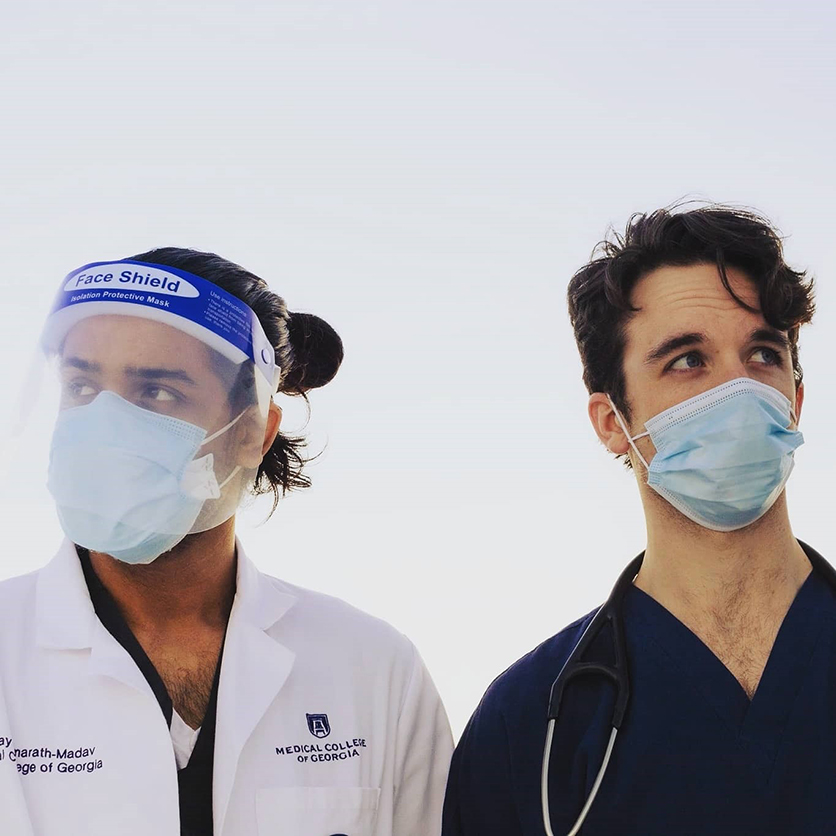
Amarath-Madav said only a handful of their friends knew of the project and that most of the shots on campus were done on weekends, a time that wouldn’t interfere with their classwork. He also said of the outdoor scenes, “Manuel’s Bread Cafe was great about supporting us in our efforts and even gave us cups to use as props.”
As of March 25, the video has 3,203 views. The three “want to thank everyone who helped make this happen. Whether you sent in a photo, helped in spreading the word of the project, shared your story of how COVID has affected you, or simply supported us in the process, from the bottom of our hearts, truly, we can’t thank you enough. This entire video is for you.”
Amarath-Madav said they hoped to reach as many people as possible so those frontline workers involved felt appreciated.
“To be honest, even if it brought that feeling to one person, I would be happy, but this is all just a bonus now, and we hope to spread the thanks as far as possible with the help of our supportive community,” he said.
Beauchamp said the views are great to see, “but really what’s been the most special are the texts, calls and emails we’ve been receiving from other frontline workers thanking us for the video and telling us how much it meant to them. That’s what this really was all about.”
Nguyen said the views will come and go, but the impact lasts longer.
“If the only thing that people remember from this project is a viral video, then we failed in our mission,” he said. “Regardless of what that view count is, whether it was 200 or 200,000, if an essential worker saw it and it brought joy and encouragement, then we did what we set out to do. We just appreciate all the kind words and stories, from even the first day of release, knowing that our message is being shared across the country and the world.”
 Augusta University
Augusta University

